Ngayong malapit na ang Holy Week, ito lamang ang
tangi kong magagawa...
Hope my researches are enough as a help for the pilgrimage of the Word.
Its about the fruit of labor of St. Paul, yepee....
NO COPY AND PASTE
lETS START THE JOURNEY BY SETTING THE SCENE
The Travel Areas of the Acts of the Apostles; also where Paul Sent his Letters
(city names in "stamped envelopes", the one province "unstamped")

Some of the Many Centres of Jewish Population Outside Israel - the "Dispersion" or "Diaspora"

THE FIRST MISSIONARY JOURNEYS STARTS with Philip the Evangelist

Taken from Acts 8:1b-40 - On that very day (the death of Stephen) a great storm of persecution burst upon the Church in Jerusalem [1]. All Church members except the apostles were scattered over the countryside of Judea [2] and Samaria [3]. While reverent men buried Stephen and mourned deeply over him, Saul (later the apostle Paul) harassed the Church bitterly. ..... Those who were dispersed by this action went throughout the country, preaching the good news of the message as they went. Philip (the "deacon" and Evangelist), for instance, went down to the city of Samaria [4] and preached Christ to the people there.
(Philip continues preaching in Samaria; the Apostles Peter and John join him there before returning to Jerusalem; Philip is then directed to another task ....)
But an angel of the Lord said to Philip, "Get up and go south down the road which runs from Jerusalem to Gaza [5], out in the desert."
Philip arose and began his journey. At this very moment an Ethiopian eunuch, a minister and in fact the treasurer to Candace, queen of the Ethiopians, was on his way home after coming to Jerusalem to worship. He was sitting in his carriage reading the prophet Isaiah.
(Philip explains a prophecy of Isaiah, preaches the Gospel of Jesus to him, and at the eunuch's request baptises him ....)
When they came up out of the water the Spirit of the Lord took Philip away suddenly and the eunuch saw no more of him, but proceeded on his journey with a heart full of joy. Philip found himself at Azotus [6] and as he passed through the countryside he went on telling the good news in all the cities until he came to Caesarea [7] (where we meet him 25 years later during a visit by Paul).
The Conversion and Earliest Journeys of Saul (Paul) of Tarsus c AD34-45
Taken from Acts 9:1-30 - But Saul (of Tarsus [1]), still breathing murderous threats against the disciples of the Lord, went to the High Priest (in Jerusalem [2]) and begged him for letters to the synagogues in Damascus [3], so that if he should find there any followers of the Way (of Jesus Christ), whether men or women, he could bring them back to Jerusalem as prisoners .....
Damascus - Capital of modern Syria. "The Pearl of the East", an ancient and important city of Syria, standing at over 2,000 feet in a large oasis. One of the city-states of The Decapolis, and a great centre of trade.
Tarsus - Capital of Cilicia in Asia Minor, and Paul's home. A Greek-speaking, Roman province in south-eastern Asia Minor, an important city and major centre of learning. Tarsus was on the highway linking Syrian Antioch and the rest of the Middle East, with the provinces of Galatia and Asia to the west.
On the road to Damascus Jesus appears in a vision to Saul who is blinded, and directs him to continue his journey to Damascus where he is healed and baptised.
According to Paul's own account in his Letter to the Galatians 1:17, he then went away to Arabia [4], before returning to Damascus [5]
In the Acts account, Paul immediately starts proclaiming Jesus in the synagogues of Damascus, before being forced to escape to Jerusalem
(Acts continues) When Saul reached Jerusalem [6], he tried to join the disciples. But they were all afraid of him, finding it impossible to believe that he was a disciple. Barnabas, however, took him by the hand and introduced him to the apostles, and explained to them how he had seen the Lord on his journey, and how the Lord had spoken to him. He further explained how Saul had spoken in Damascus with the utmost boldness in the name of Jesus. After that Saul joined with them in all their activities in Jerusalem, preaching fearlessly in the name of the Lord. He used to talk and argue with the Greek-speaking Jews, but they made several attempts on his life. When the brothers realised this they took him down to Caesarea [7] and sent him off to Tarsus [8]
(.... after which he preaches in Cilicia [9] and Syria [9], Galatians 1:21. Sometime later still, Paul is brought from Tarsus by Barnabas to work in Syrian Antioch [10], Acts 11:25 ).
The Earliest Missionary Journeys - the Apostle Peter
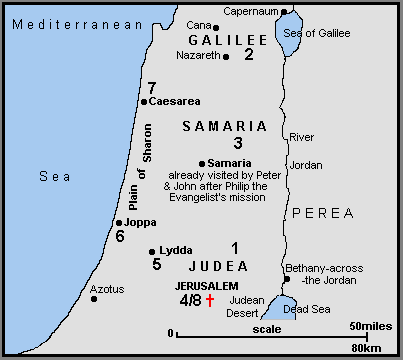
Taken from Acts 9:31-10:48 - The whole Church throughout Judea [1], Galilee [2] and Samaria [3] now enjoyed a period of peace.
...... Now it happened that Peter, in the course of travelling (from Jerusalem [4]) about among them all, came to God's people living at Lydda [5].
There he found a man called Aeneas who had been bed-ridden for eight years through paralysis. Peter said to him "Aeneas, Jesus Christ heals you! Get up and make your bed."
He got to his feet at once. And all those who lived in Lydda and (the Plain of) Sharon saw him and turned to the Lord.
Then there was a woman in Joppa [6] (who is also healed).
.... There was a man in Caesarea [7] by the name of Cornelius, a (Gentile) centurion in what was called the Italian Regiment. He was a deeply religious man who reverenced God, as did all his household. He made many charitable gifts to the people and was a real man of prayer. (He is told by an angel to send for Peter, who still in Joppa receives a vision showing that Christ is for all men - Jew and Gentile. Peter welcomes Cornelius' messengers ...)
On the next day he got up and set out with them, accompanied by some of the brothers from Joppa, arriving at Caesarea on the day after that. (Peter teaches Cornelius, his family and friends about Jesus, they receive the Holy Spirit, and he baptises them. Peter later visits Jerusalem [8] where he explains his reasons for teaching and baptising Gemtiles)
* * * * *
Apart from his journeys with Jesus, and the visit with the apostle John to Samaria after the work of Philip the Evangelist, Peter can be linked to three other locations:
(1) According to Galatians 2:11, he visited Syrian Antioch;
(2) He may have visited Corinth according to 1 Corinthians 1:12 as he was certainly known there;
(3) Traditionally he lived in Rome, and was martyred there in c AD64 or 67
The Church in Syrian Antioch Grows and Gains Gentile Converts

Taken from Acts 11:19-30 - Now those who had been dispersed by the persecution which arose over Stephen travelled as far as Phoenicia, Cyprus and (Syrian) Antioch, giving the message as they went to Jews only.
However, among their number were natives of Cyprus [1] and Cyrene [2], and these men, on their arrival at (Syrian) Antioch [3], proclaimed their message to the (Gentile) Greeks as well, telling them the good news of the Lord Jesus.
The hand of the Lord was with them, and a great number believed and turned to the Lord. News of these things came to the ears of the Church in Jerusalem [4] and they sent Barnabas to (Syrian) Antioch [5].
Syrian Antioch - present day Antakya in southern Turkey. This Antioch was known as "Queen of the East", capital of the province of Syria, and the third largest city in the Roman Empire after Rome and Alexandria. With a population of over half a million people, it was located on the River Orontes, and a junction of trade routes between East and West. It should not to be confused with Pisidian Antioch, a Phrygian town in the Roman province of Galatia -
.... Then Barnabas went to Tarsus [6] to find Saul (Paul). When he found him he brought him up to Antioch [7]. Then for a whole year they met together with the Church and taught a large crowd. It was in Antioch that the disciples were first given the name of "Christians".
During this period some prophets came down from Jerusalem to Antioch. One of them by the name of Agabus stood up and foretold by the Spirit that there was to be a great famine throughout the world. (This actually happened in the days of Claudius). The disciples determined to send relief to the brothers in Judea, each contributing as he was able. This they did, sending their contribution to the elders there (in Jerusalem [8]) personally through Barnabas and Saul (who later return to Syrian Antioch [9]).
The Letter of James is generally believed to have been the first Letter of the New Testament to be written, probably some time before the Council at Jerusalem (see Map following)
PAUL'S MISSIONARY JOURNEYS and LETTERS
Map 18. Paul's First Missionary Journey, with Barnabas to Cyprus and Asia Minor c AD46-48 and Its Sequel, the Council at Jerusalem c AD49
Taken from Acts 13:4-14:28 - So these two (Barnabas and Paul) .... went down (from Syrian Antioch [1]) to Seleucia [2] and from there sailed off to Cyprus. On their arrival at Salamis [3] they began to proclaim God's message in the Jewish synagogues, having John (Mark) as their assistant.
As they made their way through the island as far as Paphos [4] they came across a man named Bar-Jesus, a Jew who was both a false prophet and a magician. This man was attached to Sergius Paulus, the proconsul (or Roman governor of the island province of Cyprus), who was himself a man of intelligence. (Barnabas and Paul are summoned before Sergius, clash with Bar-Jesus, and Sergius Paulus becomes a believer.)
(Barnabas and Paul then sail to Asia Minor and continue on to Galatia)
Galatia - A large Roman province in Asia Minor, extending almost from the Black Sea to the Mediterranean through the mountains and plains of modern central Turkey. Settled by Gauls from central Asia in the 3rd century BC, Galatia included the Phrygian town of Pisidian Antioch; not to be confused with Syrian Antioch
Then Paul and his companions set sail from Paphos and went to Perga [5] in Pamphylia. There John (Mark) left them and turned back to Jerusalem, but they continued their journey through Perga to the Antioch in Pisidia [6]. They went to the synagogue on the Sabbath day and took their seats. (On this occasion the Gospel of Jesus is well received. A week later it is rejected and Paul and Barnabas are expelled from the district ...)
..... and went on to Iconium [7]. And the disciples continued to be full of joy and the Holy Spirit. Much the same thing happened at Iconium. ..... But when a hostile movement arose from both Gentiles and Jews in collaboration with the authorities to insult and stone them, they got to know about it, fled to the Lycaonian cities of Lystra [8] and Derbe [9], and the surrounding countryside - and from there they continued to proclaim the Gospel.
(In Lystra, they heal a crippled man and are nearly worshipped as gods)
Then some Jews arrived from Antioch and Iconium and after turning the minds of the people against Paul they stoned him and dragged him out of the city thinking he was dead. But while the disciples were gathered in a circle round him, Paul got up and walked back to the city. And the very next day he went out with Barnabas to Derbe, and when they had preached the Gospel to that city and made many disciples, they turned back to Lystra [10], Iconium [11] and Antioch [12]. ...... They then crossed Pisidia and arrived in Pamphylia. They proclaimed their message in Perga [13] and then went down to Attalia [14]. From there they sailed back to Antioch (in Syria) [15] .... When they arrived there they called the Church together and reported to them how greatly God had worked with them and how he had opened the door of faith for the Gentiles. And here at Antioch they spent a considerable time with the disciples.
Paul's Second Missionary Journey, with Silas returning to Asia Minor and on into Europe c AD49-52
Taken from Acts 15:40-18:23a - ..... Paul chose Silas and set out on his journey (from Syrian Antioch [1]) ..... He travelled through Syria [2] and Cilicia [3] and strengthened the churches.
He also went to Derbe [4] and Lystra [5]. At Lystra there was a disciple by the name of Timothy..... (who) was held in high regard by the brothers at Lystra and Iconium, and Paul wanted to take him on as his companion. ..... As they went on their way through the cities they passed on to them for their observance the decisions which had been reached by the apostles and elders in (the Council at) Jerusalem. ...
They made their way through Phyrgia [6] and Galatia [7], but the Holy Spirit prevented them from speaking God's message in Asia. When they came to Mysia [8] they tried to enter Bithynia, but again the Spirit of Jesus would not allow them. So they passed by Mysia and came down to Troas [9], where one night Paul had a vision of a Macedonian man standing and appealing to him in the words: "Come over to Macedonia and help us!"
.... So we set sail from Troas and ran a straight course to (the island of) Samothrace [10], and on the following day to Neapolis [11]. From there we went to Philippi [12], a Roman garrison-town and the chief city in that part of Macedonia. We spent some days in Philippi ....
Philippi - The ruins of Philippi are near modern Kavalla in northern Greece. It was then a city of Macedonia founded by Philip, the father of Alexander the Great. A Roman colony and military centre, governed directly from Rome, Philippi was situated on the Via Egnatian, the highway running east and west linking Rome to Byzantium (Istanbul):
(Here Paul and Silas, Timothy and sometimes Luke bring the Gospel to Lydia from Thyatira, are in conflict over a girl with a spirit of clairvoyance, are beaten and imprisoned, survive a destructive earthquake and convert their gaoler. The magistrates release them, but on learning that Paul is a Roman citizen, apologize to them and .....) after taking them outside the prison, requested them to leave the city (of Philippi) .....
Next day they journeyed through Amphipolis [13] and Apollonia [14] and arrived at Thessalonica [15]. Here there was a synagogue of the Jews which Paul entered, following his usual custom.
Thessalonica - Modern Salonika or Thessalonika. A free city, capital of the Roman province of Macedonia in northern Greece. Thessalonica was a major port, and like Philippi, located on the east-west Egnatian highway, and thus an important centre of trade by land and by sea:
(The teaching of Paul and Silas converts a large number of the people, but also infuriates many Jews. The city is in uproar .....) Without delay the brothers despatched Paul and Silas off to Beroea (or Berea) [16] that night. On their arrival there they went to the Jewish synagogue. The Jews proved more generous-minded than those in Thessalonica, for they accepted the message most eagerly ...... But when the Jews at Thessalonica found out that God's message had been proclaimed by Paul at Beroea as well, they came there too to cause trouble and spread alarm among the people. The brothers at Beroea then sent Paul off at once to make his way to the sea-coast (near Beroea) [16], but Silas and Timothy remained there.
The men who accompanied Paul took him as far as Athens [17] and returned with instructions for Silas and Timothy (still in Berea) to rejoin Paul as soon as possible.
Paul had some days to wait at Athens for Silas and Timothy to arrive (and while there, addresses some of the many philosophers of Athens, most of whom reject his teaching ...)
Before long Paul left Athens and went on to Corinth [18] where he found a Jew called Aquila, a native of Pontus. This man had recently come from Italy with his wife Priscilla because (the emperor) Claudius had issued a decree that all Jews should leave Rome. .... They all worked together, for their trade was tent-making. Every Sabbath Paul used to speak in the synagogue trying to persuade both Jews and Greeks. By the time Silas and Timothy arrived from Macedonia Paul was completely absorbed in preaching the message, showing the Jews as clearly as he could that Jesus is Christ. However, when they turned against him and abused him he shook his garments at them, and said, "Your blood be on your heads! From now on I go with a perfectly clear conscience to the Gentiles."
Corinth - The original Corinth is near modern Corinth in southern Greece. An ancient Greek city, and chief town of the Roman province of Achaia, it was at this time governed by proconsul Gallio. Located near the narrow strip of land separating the Adriatic from the Aegean Seas, and through which ran the north-south highway linking the rest of Greece with the southern Peloponnesus, Corinth was a vital centre of commerce. A cosmopolitan city with the temple of Aphrodite - goddess of love and fertility - and with two nearby ports including Cenchrea, Corinth was well known for its sexual immorality -
Then he left them and went to the house of a man called Titius Justus, a man who reverenced God and whose house was next door to the synagogue. .... Paul settled down there (in Corinth) for eighteen months (his second longest recorded stay in a city during his three Missionary Journeys) and taught them God's message.
Then, while Gallio was governor of Achaia the Jews banded together to attack Paul .... (but Gallio) flatly refuse(s) to be judge in these matters. ..... Paul stayed for some time (in Corinth) after this incident
........ and then (Paul) took leave of the brothers and sailed for Syria, taking Priscilla and Aquila with him. At Cenchrea [19] he had his hair cut short, for he had taken a solemn vow. They all arrived at Ephesus [20] and there Paul left Aquila and Priscilla, but he himself went into the synagogue and debated with the Jews. When they asked him to stay longer he refused, bidding them farewell with the words, "If if is God's will I will come back to you again" (which he does on his Third Missionary Journey). Then he set sail from Ephesus and went down to Caesarea [21]. Here he disembarked and after paying his respects to the Church in Jerusalem [22], he went down to Antioch [23]. He spent some time there before he left (on his Third Journey) ......
Paul Writes his Two Letters to the Thessalonians (during his Second Journey)
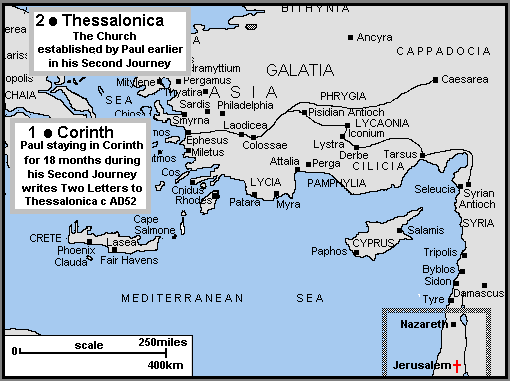
Map 21. Paul's Third Missionary Journey, returning to Asia Minor and Greece c AD53-58
Taken from Acts 18:23b-20:3a - (After spending some time in Syrian Antioch [1], Paul starts on his Third Missionary Journey, and ....) proceeded to visit systematically throughout Galatia [2] and Phyrgia [3] putting new heart into all the disciples as he went.
Now a Jew called Apollos, a native of Alexandria and a gifted speaker, well-versed in the scriptures, arrived at Ephesus. .... This man began to speak with great boldness in the synagogue. but when Priscilla and Aquila heard him they took him aside and explained the Way of God to him more accurately.
Then as he wanted to cross into Achaia, the brothers gave him every encouragement and wrote a letter to the disciples there, asking them to make him welcome. .....
Ephesus - South of modern Izmir or Smyrna in Western Turkey, and at that time capital of the Roman province of Asia. One of the three greatest cities of the eastern Mediterranean with a population of perhaps 250,000 - the other two being Alexandria in Egypt and Syrian Antioch, Ephesus was an important port with good access to the interior of Asia Minor. As a centre for the worship of Artemis or Diana - the Asian goddess of fertility, her temple was one of the seven wonders of the ancient world. The great theatre could hold 25,000 people:
While Apollos was in Corinth Paul journeyed through the upper parts of the country (the high inland plateau of Asia Minor) and arrived at Ephesus [4]. There he discovered some disciples (... who he baptises in the Holy Spirit),
Then Paul made his way into the synagogue there (in Ephesus) and for three months he spoke with the utmost confidence .... But when some of them hardened in their attitude towards the message and refused to believe it ..... Paul left them, and withdrew his disciples, and held daily discussions in the lecture-hall of Tyrannus. He continued this practice for two years (... Paul's longest recorded stay in any one location during his three Missionary Journeys), so that all who lived in Asia (not just Ephesus, but the surrounding country), both Greeks and Jews, could hear the Lord's message. (Paul continues to preach and also to heal, and with such success that a number who previously practised magic publicly burn their highly-prized books)
(Towards the end of his 3 year stay in Ephesus, Paul probably wrote his First Letter to the church in Corinth)
After these events Paul set his heart on going to Jerusalem by way of Macedonia and Achaia, remarking, "After I have been there I must see Rome as well." .
Then he despatched to Macedonia (the province that included the cities of Philippi and Thessalonica) two of his assistants, Timothy and Erastus, while he himself stayed for a while in Asia.
(Paul is now publicly attacked by the many craftsmen whose livelihood depends on the worship of the goddess Diana and a near-riot ensues)
...... After this disturbance had died down, Paul sent for the disciples and after speaking encouragingly said good-bye to them, and went on his way to Macedonia [5]. As he made his way through these districts (... of Macedonia, Paul probably wrote his Second Letter to the Corinthians after Titus' return from Corinth) .... he spoke many heartening words to the people and then went on to Greece [6] (including Corinth), where he stayed for three months.
(During his stay in Corinth, Paul is believed to have written his Letter to the church in Rome. According to this Letter, either on his way from Macedonia or during his three months stay in Greece, Paul led or organised a mission to Illyricum or Dalmatia - the area of the old Yugoslavia.)
PAUL'S THIRD MISSIONARY JOURNEY CONCLUDED; THE RETURN TO JERUSALEM c AD58
Taken from Acts 20:3b-12 - 21:15 - Then (after staying in Greece [6] ...) when he (Paul) was on the point of setting sail for Syria the Jews made a further plot against him and he decided to make his way back (by land) through Macedonia [7]. His companions on the journey were Sopater a Beroean ... two Thessalonians ... Gaius from Derbe, Timothy, and two Asians..... This party proceeded to Troas to await us there while we sailed from Philippi [8] after the days of unleavened bread. and joined them five days later at Troas [9], where we spent a week.
(At Troas, Paul's lengthy teaching almost leads to the death of a young man Eutychus who goes to asleep and falls out of window!)
Meanwhile we had gone aboard the ship and sailed on ahead for Assos, intending to pick up Paul there ..... since he himself had planned to go overland. When he met us on our arrival at Assos [10] we took him aboard and went on to Mitylene [11]. We sailed from there and arrived off the coast of Chios [12] the next day. On the day following we crossed to Samos [13], and the day after that we reached Miletus [14]. For Paul had decided to sail past Ephesus with the idea of spending as little time as possible in Asia. He hoped, if it should prove possible, to reach Jerusalem in time for the day of Pentecost.
At Miletus he sent to Ephesus to summon the elders of the Church. On their arrival he addressed them ...... What saddened them most of all was his saying that they would never see his face gain......
When we had finally said farewell to them we set sail, running a straight course to Cos [15], and the next day we went to Rhodes [16] and from there to Patara [17]. Here we found a ship bound for Phoenicia, and we went aboard her and set sail. After sighting Cyprus [18] and leaving it on our left we sailed to Syria and put in at Tyre [19], since that was where the ship was to discharge her cargo. We sought out the disciples there and stayed with them for a week (... the disciples warn Paul not to go up to Jerusalem). ..... We sailed away from Tyre and arrived at Ptolemais [20]. We greeted the brothers there and stayed with them for just one day. On the following day we left and proceeded to Caesarea [21] and there we went to stay at the house of Philip the evangelist (... again he is warned of the dangers of returning to Jerualem).
After this we made our preparations and went up to Jerusalem [22].
PAUL'S LETTERS
Writes his First Letter to the Corinthians

Paul Writes his Second Letter to the Corinthians

Paul Writes to the Galatians

Paul Writes to the Romans
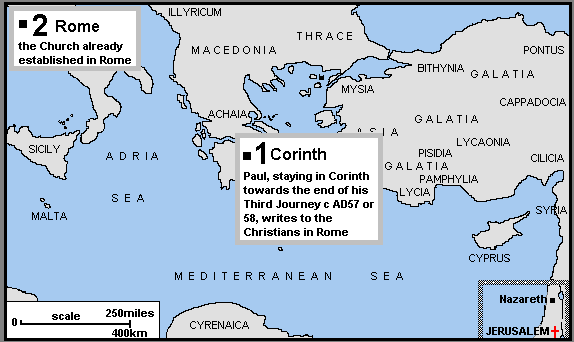
Paul's Journey under Arrest from Palestine to Rome c AD58-61
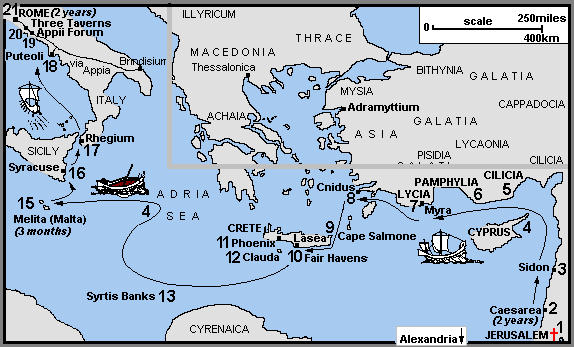
Taken from Acts 27:12 - 28:31 - ..... (two years after Paul's original arrest in Jerusalem [1] and his journey to Caesarea [2]), Paul and some other prisoners were put in charge of a centurion named Julius...... We embarked on a ship hailing from Adramyttium, bound for the Asian ports, and set sail. .....
On the following day we put in at Sidon [3], where Julius treated Paul most considerately by allowing him to visit his friends and accept their hospitality.
From Sidon we put to sea again and sailed to leeward of Cyprus [4], since the wind was against us. Then, when we had crossed the gulf that lies off the coasts of Cilicia [5] and Pamphylia [6], we arrived at Myra [7] in Lycia. There the centurion found an Alexandrian ship bound for Italy and put us aboard her. For several days we beat slowly up to windward and only just succeeded in arriving off Cnidus [8]. Then, since the wind was still blowing against us, we sailed under the lee of Crete, and rounded Cape Salmone [9]. Coasting along with difficulty we came to a place called Fair Havens [10], near which is the city of Lasea. .........
(In spite of Paul's warnings, the ship continued on its way) ...... the majority were in favour of setting sail again in the hope of reaching Phoenix [11] and wintering there. Phoenix is a harbour in Crete, facing south-west and north-west. So, when a moderate breeze sprang up, thinking they had obtained just what they wanted, they weighed anchor, and coasted along, hugging the shores of Crete. But before long a terrific gale, which they called a north-easter, swept down upon us from the land. The ship was caught by it and since she could not be brought up into the wind we had to let her fall off and run before it. Then, running under the lee of a small island called Clauda [12], we managed with some difficulty to secure the ship's boat. After hoisting it aboard they used cables to brace the ship. To add to the difficulties they were afraid all the time of drifting on to the Syrtis banks [13], so they shortened sail and lay to, drifting. (The writer of Acts then describes the terrible storm which finally casts them up alive on the shore of Malta) .... On the fourteenth night of the storm, as we were drifting in the Adriatic [14], about midnight the sailors sensed that we were nearing land. .....
After our escape we discovered that the island was called Melita [15]. ... (Paul's stay on Malta is described) ..... ... It was no less than three months later that we set sail in an Alexandrian ship which had wintered in the island ...... We put in at Syracuse [16] and stayed there three days, and from there we tacked round to Rhegium [17]. A day later the south wind sprang up and we sailed to Puteoli [18], reaching it in only two days. There we found some of the brothers and they begged us to stay a week with them, and so we finally came to Rome.
The brothers there had heard about us and came out from the city to meet us, as far as the Market of Appius [19] and the Three Taverns [20]. ....
When we reached Rome [21] Paul was given permission to live alone with the soldier who was guarding him (where he stayed for at least two years after which he was either executed or released).
Paul writes from Prison in Rome - to Colossians, Philemon, Ephesians and Philippians

Paul Writes his First Pastoral or Teaching Letter to Timothy
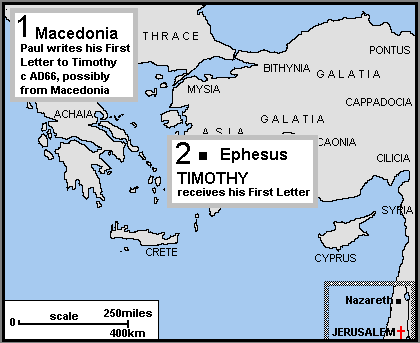
Paul Writes his Pastoral or Teaching Letter to Titus
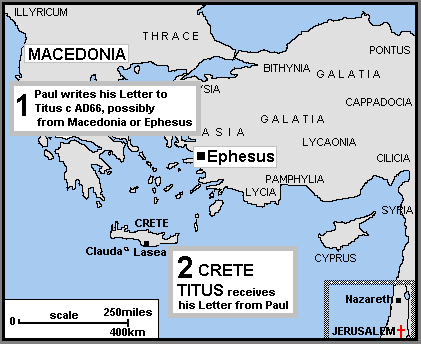
Paul Writes his Second Pastoral or Teaching Letter to Timothy
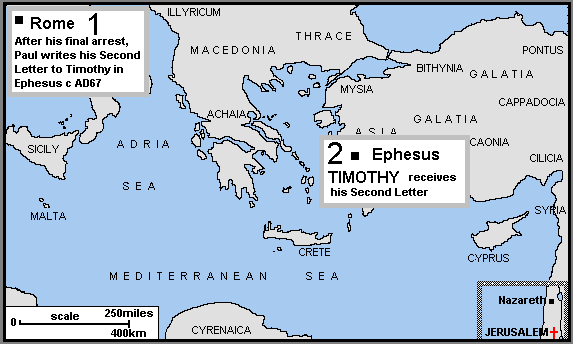
GENERAL LETTERS and REVELATION
Only the First Letter of Peter and the Book of Revelation is included here. The Letter of James is generally believed to have been the first Letter of the New Testament to have been written, probably some time before the Council at Jerusalem. The Letter to the Hebrews and the other General or Catholic Letters - Second Letter of Peter, First, Second, and Third Letters of John, and the Letter of Jude, although written around this time are not included.
Where Hebrews, 2 Peter and Jude were written and their destinations are generally very uncertain. The three Letters of John were probably written in Ephesus probably all to addresses in the Province of Asia (see Map 31 following)
Peter Writes His First Letter, to the Christian Jews of Most of Asia Minor

Book of Revelation - John Writes to Seven Churches in the Province of Asia

The reading proper starts here. The above are just meer visualization of this. This is all "the meat without the fat".
Paul is one of the outstanding people in the Bible. He walks miles, and continents to be able to spread th egood news for everyone. ANd now, we just reap the very fruit of his labor. But why St. Paul and why love ST. Paul, its because of this...
Paul was born in Tarsus, southern part of Turkey in ancient Cilicia. His date of birth is placed by the scholars between 1 AD and  6th AD. He was named after Saul, the first king of Israel. He came from a rich and powerful Jewish family. His father or his relatives obtained the Roman citizenship and full civil rights of the city of Tarsus.
6th AD. He was named after Saul, the first king of Israel. He came from a rich and powerful Jewish family. His father or his relatives obtained the Roman citizenship and full civil rights of the city of Tarsus.
Educated by his mother and his father during his early years, Paul was sent to Jerusalem for further studies and studied at the academy of Gameliel, one of the most respected Jewish teachers. During the early years, he took action against Christians and took part in their persecutions. His name spread all over the Roman world and created fear. His life totally changed after his vision when Christ appeared to him on the way to Damascus. Christ appeared to him and said:
"Paul, why you persecute me"
Paul who got blind after his vision, he was healed with the help of one of the disciples. When he returned to Jerusalem great difficulties were waiting for him. Neither Christian nor Jewish believed or trusted him. He returned to his home town, Tarsus. His writings no where indicate that he knew Jesus or his disciples. He left Jerusalem and returned Tarsus during the Christ's ministry and he didn't return to Jerusalem till Jesus' death.
After Saint Barnabas found him in Tarsus and persuaded him to come to Antioch with him, Saint Paul made three great successive journeys which covered big part of Anatolia and Greece. Finally, after his third missionary trip, he was arrested in Jerusalem. Since he wanted to appeal to Ceaser, he was taken to Rome. After two years imprisonment in Rome, he was found innocent and was freed.
Paul and Peter were arrested after the great fire of Rome and were blamed for. Peter was crucified up side down on the capitol hill where there is great church of Vatican now. As to Paul, since he was a Roman citizen he was beheaded near Ostia gate in Rome.
First Missionary Journey of Paul
Found inActs:13-14 -and happened on AD 46-48
 Paul, Barnabas and John Mark started their missionary Journey from Syrian Antioch in the year of 47 AD. They went to harbor town of Seleucia and sailed first to Salamis in Cyprus from where Barnabas was originated. They arrived to Salamis ( Acts 13:4-5), one of the great commercial harbors of Cyprus. They proclaimed the word of God the synagogues of Jews. They passed the island from the east to west and arrived the city of Paphos, the center of Roman rule and the cult of Aphrodite. The city of Paphos had an evil reputation for the laxity of moral of its inhabitants. Paul and companions met the Roman Proconsul, Sergius Paulos and the sorcerer called Elimas who was blinded by Paul. Proconsul became one of the believers and from this point on Saul started using this Roman name, Paul, Paul and friends then sailed for Pamphilia, south west Anatolia. They possibly arrived to Attalia, the main port of the region and moved to Perge, the most important city of Pamphilia region. Paul didn't stay long time in Perge. Young John Mark left the party. He was either scared of dangerous trip to north through the Taurus mountains or irritated by the leadership of Paul in the group or he was homesick. Paul and Barnabas journeyed towards Pisidian Antioch, located 100 miles in the north of Perge. In Pisidian Antioch Paul utters his historical words:
Paul, Barnabas and John Mark started their missionary Journey from Syrian Antioch in the year of 47 AD. They went to harbor town of Seleucia and sailed first to Salamis in Cyprus from where Barnabas was originated. They arrived to Salamis ( Acts 13:4-5), one of the great commercial harbors of Cyprus. They proclaimed the word of God the synagogues of Jews. They passed the island from the east to west and arrived the city of Paphos, the center of Roman rule and the cult of Aphrodite. The city of Paphos had an evil reputation for the laxity of moral of its inhabitants. Paul and companions met the Roman Proconsul, Sergius Paulos and the sorcerer called Elimas who was blinded by Paul. Proconsul became one of the believers and from this point on Saul started using this Roman name, Paul, Paul and friends then sailed for Pamphilia, south west Anatolia. They possibly arrived to Attalia, the main port of the region and moved to Perge, the most important city of Pamphilia region. Paul didn't stay long time in Perge. Young John Mark left the party. He was either scared of dangerous trip to north through the Taurus mountains or irritated by the leadership of Paul in the group or he was homesick. Paul and Barnabas journeyed towards Pisidian Antioch, located 100 miles in the north of Perge. In Pisidian Antioch Paul utters his historical words:
"Now, we turn to Gentiles"
After Pisidian Antioch, Paul and Barnabas moved to Lystra where people thought that Paul and Barnabas were Gods. When they learned about the truth, they tried to persecute Paul and Barnabas. Paul was stoned and beaten to such an extent that people thought he had died. Next city they would arrive was Derbe where the apostles made a lot of disciples and one of them was Gaius who accompanied Paul during his last missionary journey. Paul after staying for a while in Derbe. He starts his return journey by retracing their initial road. hey returned to Attalia from where they set sail to Antioch to report the results of his missionary journey. The first journey which lasted 18 months ended in the fall of 47 AD.
Acts: 15:36-4;16-18 AD 49-51
 Second journey of Paul started from Syrian Antioch. This time, he was accompanied by Silas. Wishing to revisit some of the cities he visited during the first missionary journey, he went to Tarsus, Derbe, Lystra and some other cities of Galatia. Then Paul wanted to go to the Asian province of the Roman Empire but he was prevented by the Holly Sprit from going there. Then he wanted to go north to Bytinia Region but this time, he was prevented by the spirit of Christ. Paul and companions were guided towards Troas, a city in the south of Dardaneles, a popular crossing point from Asia to Europa. When Paul arrived there, he had his famous vision. In his dream, he had a man from Macedonia beseeching to come over to Macedonia to help them. From the Acts of Apostles, we also understand that Luke, the author of the Fourth Gospel and the writer of the Acts of Apostles joined to Paul's Party. Paul and companions first went to island of Samothrace, then arrived to Neapolis and Philippi where Paul met Lydia, a rich women from the city of Thyatira. In Philippi, Paul was disturbed by a mentally irritated slave girl who had peculiar powers. She was healed by Paul and she and her family were baptized by Paul who was arrested and put into a prison upon complains of the owners of the girl. Paul's party continued their journey and they passed Amphipolis, Apollonia, Thessalonica and arrived Athens where he has bitter argument with the philosophers of the city. Going to further south Paul arrived the city of Corint, one of the important cities of southern Greece. After staying nearly 1 year, he traveled to Ephesus, the capital city of Asia. He was accompanied by Aqilia and Prisqilla, close friends of Paul from Corint. Paul first went to Synagogues of Ephesus and spoke with the elders of the synagogues and argued with them Christian doctrines. He didn't stay long time in Ephesus to keep the feast (passover) in Jerusalem. After promising he would return to Ephesus, he left for the Holy lands.
Second journey of Paul started from Syrian Antioch. This time, he was accompanied by Silas. Wishing to revisit some of the cities he visited during the first missionary journey, he went to Tarsus, Derbe, Lystra and some other cities of Galatia. Then Paul wanted to go to the Asian province of the Roman Empire but he was prevented by the Holly Sprit from going there. Then he wanted to go north to Bytinia Region but this time, he was prevented by the spirit of Christ. Paul and companions were guided towards Troas, a city in the south of Dardaneles, a popular crossing point from Asia to Europa. When Paul arrived there, he had his famous vision. In his dream, he had a man from Macedonia beseeching to come over to Macedonia to help them. From the Acts of Apostles, we also understand that Luke, the author of the Fourth Gospel and the writer of the Acts of Apostles joined to Paul's Party. Paul and companions first went to island of Samothrace, then arrived to Neapolis and Philippi where Paul met Lydia, a rich women from the city of Thyatira. In Philippi, Paul was disturbed by a mentally irritated slave girl who had peculiar powers. She was healed by Paul and she and her family were baptized by Paul who was arrested and put into a prison upon complains of the owners of the girl. Paul's party continued their journey and they passed Amphipolis, Apollonia, Thessalonica and arrived Athens where he has bitter argument with the philosophers of the city. Going to further south Paul arrived the city of Corint, one of the important cities of southern Greece. After staying nearly 1 year, he traveled to Ephesus, the capital city of Asia. He was accompanied by Aqilia and Prisqilla, close friends of Paul from Corint. Paul first went to Synagogues of Ephesus and spoke with the elders of the synagogues and argued with them Christian doctrines. He didn't stay long time in Ephesus to keep the feast (passover) in Jerusalem. After promising he would return to Ephesus, he left for the Holy lands.
After his journey from Ephesus, Paul landed in Caeserea on the coastline of Palestine. Then he went up before to Jerusalem and finally to Antioch.
Acts 18:23-28;19-21 - AD 53-57
 When Paul started his third missionary trip, the city in his mind was Ephesus and that was the main aim of his third trip. On the way to Ephesus, he revisited some of the cities of Galacia and traveled to Ephesus where he worked 2 and half years. His missionary work in Ephesus ended with the Silversmith Riot which forced Paul to leave. Planning to go to Macedonia, Paul stopped at Troas where he possibly spent few months of winter till he got the suitable weather for safe journey for northern Greece. Paul and his companions continued their journey to Macedonia where they spent nearly 18 then mouths in the Greece. Because of several attempts of murder, Paul didn't have a ship from Corint but returned to Troas where he had his miracle related to young boy who fell from the window of s Roman House. Instead of taking the boat with his friends, he preferred walking 20 miles over the mountains to Assos. After Assos, Paul's boat stops the some Aegean islands such as Mitytline, Chios and Samos. Paul's boat stopped in Miletos where he met the elders of the Ephesians Church. It was a touching ceremony in the Lion Harbor of Ephesus. Everyone cried. They all knew they wouldn't see each other after this meeting. Paul, after staying 3 days, he left for Holy Lands.
When Paul started his third missionary trip, the city in his mind was Ephesus and that was the main aim of his third trip. On the way to Ephesus, he revisited some of the cities of Galacia and traveled to Ephesus where he worked 2 and half years. His missionary work in Ephesus ended with the Silversmith Riot which forced Paul to leave. Planning to go to Macedonia, Paul stopped at Troas where he possibly spent few months of winter till he got the suitable weather for safe journey for northern Greece. Paul and his companions continued their journey to Macedonia where they spent nearly 18 then mouths in the Greece. Because of several attempts of murder, Paul didn't have a ship from Corint but returned to Troas where he had his miracle related to young boy who fell from the window of s Roman House. Instead of taking the boat with his friends, he preferred walking 20 miles over the mountains to Assos. After Assos, Paul's boat stops the some Aegean islands such as Mitytline, Chios and Samos. Paul's boat stopped in Miletos where he met the elders of the Ephesians Church. It was a touching ceremony in the Lion Harbor of Ephesus. Everyone cried. They all knew they wouldn't see each other after this meeting. Paul, after staying 3 days, he left for Holy Lands.
Acts 18:23-28;19-21 - AD 53-57
 When Paul started his third missionary trip, the city in his mind was Ephesus and that was the main aim of his third trip. On the way to Ephesus, he revisited some of the cities of Galacia and traveled to Ephesus where he worked 2 and half years. His missionary work in Ephesus ended with the Silversmith Riot which forced Paul to leave. Planning to go to Macedonia, Paul stopped at Troas where he possibly spent few months of winter till he got the suitable weather for safe journey for northern Greece. Paul and his companions continued their journey to Macedonia where they spent nearly 18 then mouths in the Greece. Because of several attempts of murder, Paul didn't have a ship from Corint but returned to Troas where he had his miracle related to young boy who fell from the window of s Roman House. Instead of taking the boat with his friends, he preferred walking 20 miles over the mountains to Assos. After Assos, Paul's boat stops the some Aegean islands such as Mitytline, Chios and Samos. Paul's boat stopped in Miletos where he met the elders of the Ephesians Church. It was a touching ceremony in the Lion Harbor of Ephesus. Everyone cried. They all knew they wouldn't see each other after this meeting. Paul, after staying 3 days, he left for Holy Lands.
When Paul started his third missionary trip, the city in his mind was Ephesus and that was the main aim of his third trip. On the way to Ephesus, he revisited some of the cities of Galacia and traveled to Ephesus where he worked 2 and half years. His missionary work in Ephesus ended with the Silversmith Riot which forced Paul to leave. Planning to go to Macedonia, Paul stopped at Troas where he possibly spent few months of winter till he got the suitable weather for safe journey for northern Greece. Paul and his companions continued their journey to Macedonia where they spent nearly 18 then mouths in the Greece. Because of several attempts of murder, Paul didn't have a ship from Corint but returned to Troas where he had his miracle related to young boy who fell from the window of s Roman House. Instead of taking the boat with his friends, he preferred walking 20 miles over the mountains to Assos. After Assos, Paul's boat stops the some Aegean islands such as Mitytline, Chios and Samos. Paul's boat stopped in Miletos where he met the elders of the Ephesians Church. It was a touching ceremony in the Lion Harbor of Ephesus. Everyone cried. They all knew they wouldn't see each other after this meeting. Paul, after staying 3 days, he left for Holy Lands.





No comments:
Post a Comment